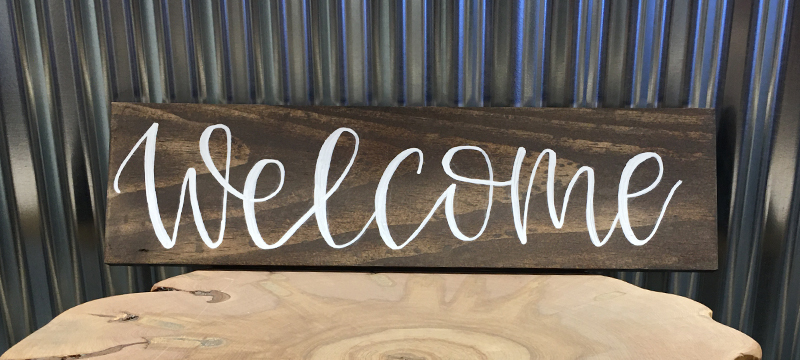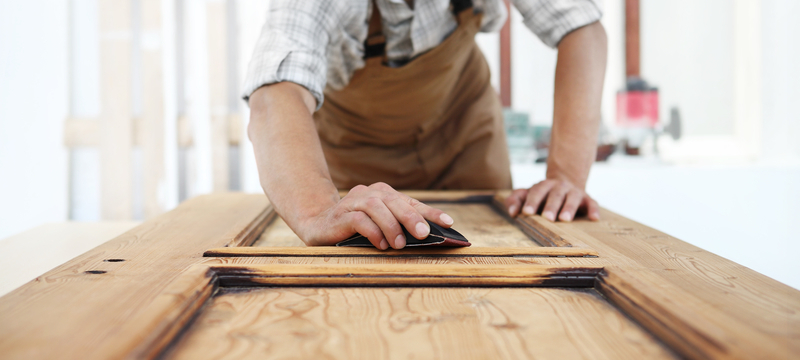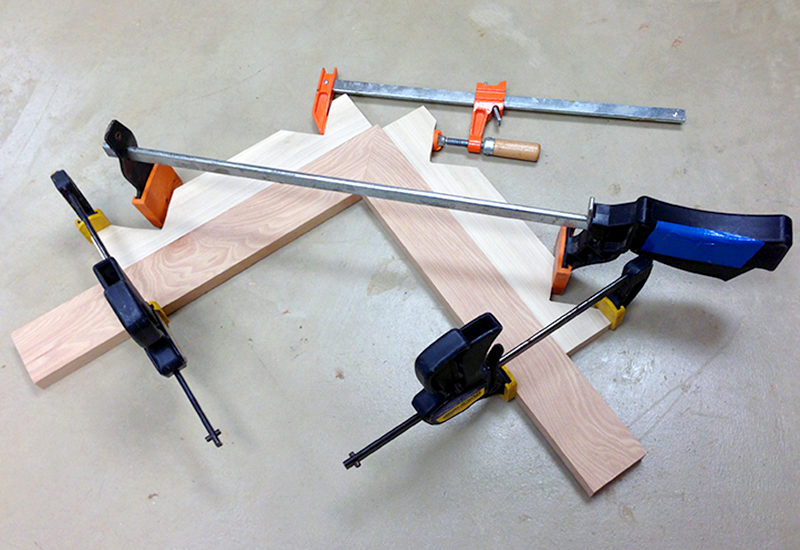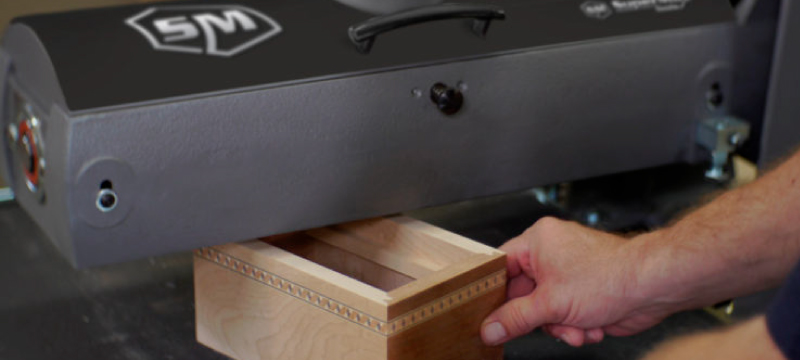A wood sign makes a great decorative piece, and they are fun builds to work on. We are sharing our latest DIY project to add personalization to your decor. Use the tools below or whatever you have on hand, and as always, shop Acme Tools for any tools needed.
Wood Sign Materials

- 4”x 18” piece of wood
- 3M Paint Sanding Respirator Mask
- Makita 5” Random Orbital sander
- 80-grit, 120-grit, and 150-grit sanding discs
- (1) Drop cloth
- Foam brushes
- Disposable (Rubber-Preferred) gloves
- Wood stains or finishes
- Minwax Polyacrylic protective finish
- Ruler or tape measure
- Painters tape
- White Chalk or pastel pencil
- Molotow Paint pens
- Sawtooth hanger
DIY Project Guide
Step 1
Start the wood sign by deciding the board size and type of wood you would like to use. The piece used in this project was cut and ripped from a generic 2″ x 4″ that we had on hand from scrap. If you are cutting your wood, use power tools with the correct safety gear as recommended.
Step 2

We will move on to sanding after the wood is cut to size. Sanding allows the stain to go on smoothly and makes the lettering process more accessible because a smooth surface will not rip your brushes or pens.
We used a Makita 5″ orbital sander and started with 80-grit sandpaper. The first sanding pass will do some of the work by removing imperfections in the wood and leveling the surface. The second grit is used to smooth the previous pass. It is always an innovative idea to sand the edges just a little to prevent snagging or injury when being managed. Once the piece is sanded, wipe it down with a dry cloth to remove all excess dust.
Remember to wear a respirator or dust mask when sanding so that the dust particles are not inhaled. Also, make sure you are wearing proper eye protection.
Step 3
Next, find an indoor or outdoor location to start staining in. When using an oil-based stain like the Minwax English Chestnut, ensure airflow because the smell can overwhelm you.

Ensure that the stain is stirred and mixed well. You can get wood sticks or dowels to stir in your paint section at your home improvement or hardware store. Using a foam brush, lightly dip the brush in the stain and remove any excess by dragging the brush lightly against the inner edge of your stain can. Stain the board against the grain first. This allows the stain to get into the pores of the wood. We stain against the grain and then push the excess stain with the grain so there is no thick layer of stain.
If you want a darker stain for your wood sign, a layer can be left on for as short as 5 minutes or even up to multiple hours, depending on the desired darkness. For this project, the stain went against the grain first and then stroked with the grain to remove the excess for a more natural-looking stain. Allow the paint to dry for 12-24hrs. If the board feels tacky or sticky, it is not dry!
This project is best over a few days, especially if using an oil-based stain and depending on the desired darkness. You can choose to stain one side or both, depending on preference.
Step 4
When the stain is dry, add a polyacrylic protective spray finish coat. This step ensures that the porosity of the wood or the amount of stain used will not cause the paint to bleed. This step can be skipped, but it is not recommended. If you ignore this step, be extra careful with the lettering portion.
Step 5

After the polyacrylic is completely dry, you want to decide what word/name you want to letter on your board. Using the tape, measure chalk/pastel pencil and mark the middle of the board. You will want to give space on each side for your word. We went in 2.5″ on each side for this board, leaving 13″ of workspace for lettering. Then, the painter’s tape was put along the bottom and top edges of the board. This makes sure that the lettering does not fall off the edge. The middle letter of the word will go on the middle of the board.
Step 6
Using the chalk pencil, lightly write the middle letter, then move to the right or left to finish the word. This makes sure that the word is centered on the board. You will want to write out your words with enough space between the letters for the thickness of the calligraphy.
Step 7

Once you are satisfied with the spacing of your word, you are ready to use the Molotow paint pen to write/paint the word on the board. The rule of thumb with hand lettering calligraphy is thin on the upstroke and thick on the downstroke. There are many online resources to learn calligraphy or modern brush lettering, but this is the first rule of the process.
When using the Molotow paint pen, you want to shake it vigorously with the cap on. We always use a scrap piece of wood or dark paper to evaluate the flow of my pen and keep the ink flowing.
PRO TIP: if you pump it too much, it will flood. Ensure you always pump your pen on your scrap and never on your project, or you will end up with an ink puddle.
Step 8
Do one layer with the Molotow Paint pen and wait 10-15 minutes for the first layer to dry. Then add your thickness on the down strokes of your word and extra layers for a brighter white. Results may vary depending on how much polyacrylic you sprayed on and the porosity of the wood you chose.
Step 9
When finished lettering, let dry for about an hour or even overnight. If you have leftover chalk on your board, use a clean pencil eraser or a DRY cloth to wipe away access. You do not want to use a damp cloth because that will press the chalk or pastel into the wood and leave a white residue or shadow.
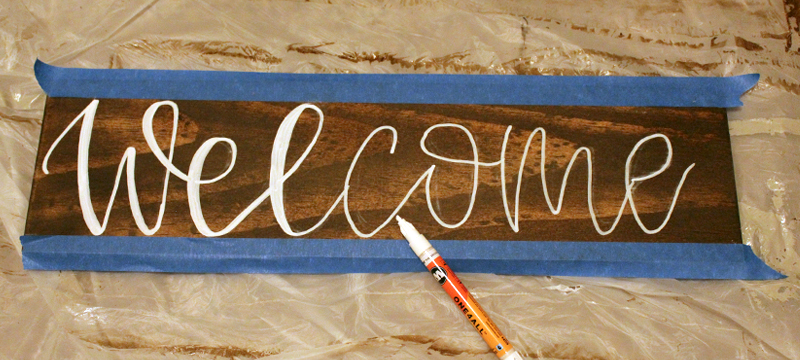
Step 10
Once the board is all cleaned up, it is ready for its final coat of polyacrylic to seal. If your wood sign is going outside, do multiple coats over time. Three coats should suffice. Make sure each coat is dry before adding another coat.
Step 11
The ultimate step is to add your sawtooth hanger. Depending on the length of your board, you can use one hanger in the middle. You can use two on each side if your board is longer or heavier.
About the Author
Author: Kayla G.
Kayla G. was a previous digital and web designer at Acme Tools. Today, she operates as our Acme Tools Email & SMS Coordinator. In any case, Her love for creating started incredibly early with a passion for drawing. Her interest in calligraphy and woodworking stemmed from her busy schedule and needing a creative outlet. If she is not doing Brazilian Jiu Jitsu, she is at home with her two cats and husband, making her artistic ideas come to life.

